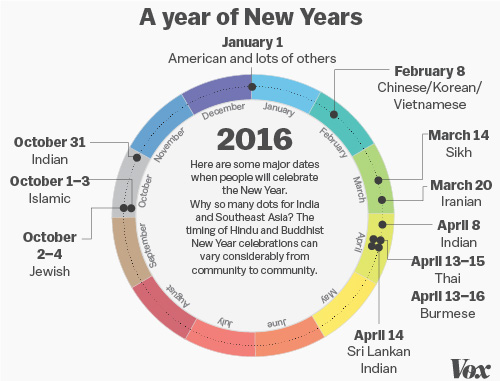Have you ever wondered why New Year’s Eve fireworks explode across the sky on January 1st in some parts of the world, while others celebrate with colorful lanterns in February or even spring festivals in April? The way we mark the beginning of a new year is a window into the beliefs, traditions, and histories of different cultures. It’s a fascinating tapestry woven with ancient rituals, historical events, and modern interpretations.

Image: www.kimkim.com
This exploration delves into the diverse ways cultures around the world celebrate the new year, moving beyond the familiar Western calendar. We’ll uncover the rich tapestry of traditions, from the explosive festivities of Chinese New Year to the joyous celebrations of Hindu festivals, and more. Let’s embark on a global journey to understand the unique ways different cultures mark the passage of time and embrace the promise of a fresh start.
The Lunar New Year: A Celebration of Renewal
In many East Asian cultures, the new year isn’t tied to the Gregorian calendar but instead follows the lunar cycle. This annual event, known as Lunar New Year, is a time for family reunions, feasting, and seeking good fortune. The specific date for Lunar New Year varies, but it typically falls sometime between January 21st and February 20th.
China: The Year of the…
For the Chinese, the Lunar New Year, known as *Chun Jie* (Spring Festival), is the most important holiday of the year. Traditionally, it’s a time to honor ancestors, pay respects to deities, and welcome spring. The festivities are vibrant and packed with symbolic traditions, including red decorations, fireworks, lion dances, and gift-giving. The Chinese zodiac assigns each year to one of twelve animals, with 2023 being the Year of the Rabbit.
Vietnam: Tet
In Vietnam, Lunar New Year is called *Tet*, a time of profound renewal. Family gatherings, colorful decorations, and vibrant parades fill the streets. The Vietnamese place great emphasis on ancestor worship during Tet and often visit their family graves to pay respects. Red envelopes filled with money are exchanged between family members as a symbol of good luck.

Image: www.vox.com
Korea: Seollal
For Koreans, the Lunar New Year is *Seollal*, a time to strengthen family ties and reflect on the past year. Traditional foods like *tteokguk* (rice cake soup) and *jeon* (pancakes) are enjoyed. A key tradition is *sebae*, a ritual bowing to elders as a sign of respect and gratitude.
The Hindu Solar Calendar: A Time for Festivals
In India and other parts of South Asia, the new year is celebrated according to the Hindu calendar, which follows the solar cycle. A number of festivals mark the beginning of new year celebrations, each with its own unique traditions and symbolism.
Ugadi: The New Year in Andhra Pradesh and Karnataka
In the southern Indian states of Andhra Pradesh and Karnataka, the new year begins with the festival of *Ugadi*, which typically falls in March or April. Ugadi literally translates to “the beginning of the year,” and its celebration reflects the hopes for a prosperous year ahead. The festival features a vibrant dish called *panchangam* containing a symbolic mix of flavors, each representing a different aspect of life.
Gudi Padwa: The New Year in Maharashtra
In Maharashtra, the new year is celebrated as *Gudi Padwa* in March or April. It’s a vibrant festival, marked by colorful decorations featuring a *gudi* (a small flag adorned with flowers and a cloth) that is hoisted outside homes to welcome prosperity. A variety of sweets like *puran poli* (stuffed bread) are enjoyed, symbolizing the sweetness of life.
Vishu: The New Year in Kerala
Kerala, a state in southwest India, celebrates the new year as *Vishu* in late April. The festival is a time for good fortune and abundance. On Vishu day, families wake up to a beautifully arranged *kanni*, a traditional offering of fruits, gold ornaments, rice, and yellow flowers. The sight of this offering, symbolizing prosperity, is believed to bring good luck for the year ahead.
Other Cultures, Diverse Celebrations:
The world is a vibrant tapestry of cultures, each with its own unique way to usher in the new year.
The Persian New Year: Nowruz
Nowruz, the Persian New Year, is celebrated on the vernal equinox, usually around March 21st. It marks the beginning of spring and is a time of renewal and rebirth. A symbol of Nowruz is the *haft-seen*, a table adorned with seven items that begin with the letter “s” in Persian, each signifying a different aspect of life.
The Ethiopian New Year: Enkutatash
Ethiopia marks its new year on September 11th, known as *Enkutatash*. This joyful celebration centers on feasting, dancing, and the exchange of gifts. The name “Enkutatash” means “gift of the year,” highlighting the spirit of generosity that characterizes the day.
The Significance of New Year Celebrations:
The diverse ways cultures celebrate the new year offer a glimpse into their history, beliefs, and values. Across the globe, these events serve as a time for reflection, renewal, and hope. From the auspicious rituals of Lunar New Year to the vibrant festivities of Hindu festivals, each celebration weaves a unique thread in the tapestry of human culture. These celebrations not only mark the passing of time but also strengthen cultural identity and provide opportunities for communities to come together.
When Do Other Cultures Celebrate The New Year
Looking Ahead:
As we’ve explored the diverse ways cultures around the world celebrate the new year, we can see the richness and beauty of human traditions. This journey has provided insights into why dates for celebrations differ and how they reflect the values and beliefs of each culture. While the Gregorian calendar dictates when January 1st arrives, the true spirit of the new year lies in the hope and anticipation we carry for a fresh start, a sense of community, and the promise of a brighter future.






